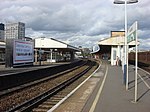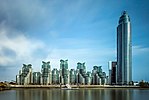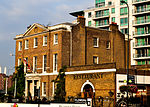Vauxhall bus station
Bus stations in LondonTransport in the London Borough of LambethUse British English from June 2017Vauxhall

Vauxhall bus station is a bus station in Vauxhall, in the London Borough of Lambeth. It is operated by London Buses and owned and maintained by Transport for London, and is the second busiest bus station in the city.The station, which is adjacent to the Vauxhall railway and tube stations, is situated on Bondway between Wandsworth Road, Kennington Road and Parry Street.
Excerpt from the Wikipedia article Vauxhall bus station (License: CC BY-SA 3.0, Authors, Images).Vauxhall bus station
Bridgefoot, London Vauxhall (London Borough of Lambeth)
Geographical coordinates (GPS) Address External links Nearby Places Show on map
Geographical coordinates (GPS)
| Latitude | Longitude |
|---|---|
| N 51.4855 ° | E -0.1243 ° |
Address
Vauxhall Bus Station
Bridgefoot
SW8 2FH London, Vauxhall (London Borough of Lambeth)
England, United Kingdom
Open on Google Maps






